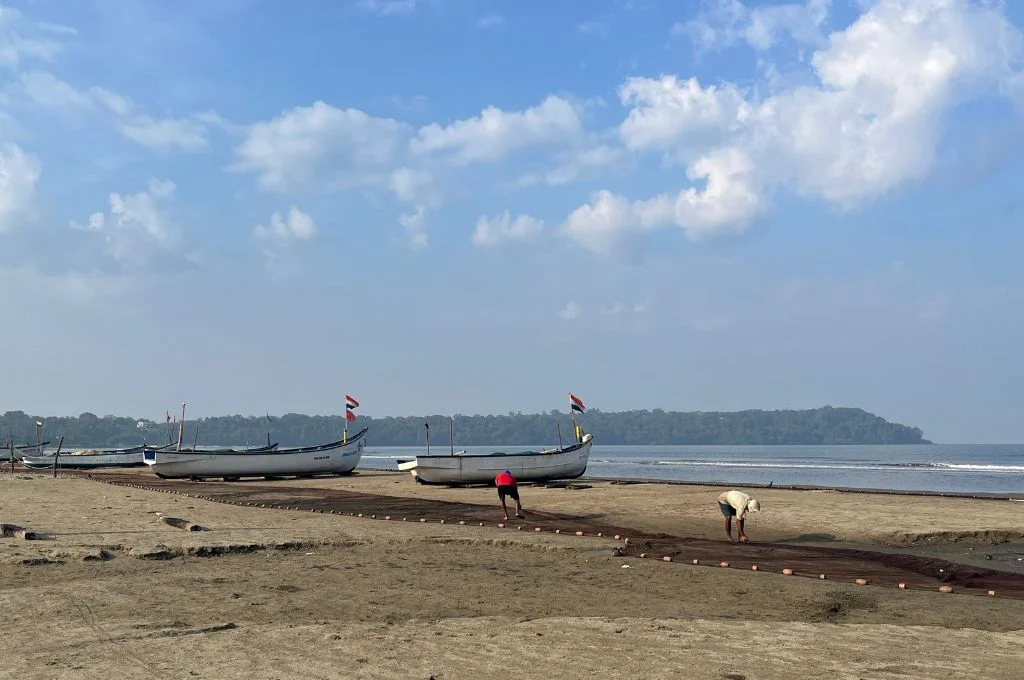
At 7 am, it is already very hot. Mahesh has just brought the boat far up the beach, away from the waves. Under a bright-green tarp held up by four long wooden posts driven deep into the sand, he carefully unwinds a fishing net to pick out the day’s catch. Mahesh is a migrant worker from Odisha and only began working in the fishing villages around Panaji, Goa, a few years ago.
A little ways from the sea, palm trees and vegetation—both natural and non-indigenous—grow on the coastal dunes. In the shade of the trees are armchairs as well as shack-like structures with palm fronds for roofs. Mahesh says that the fishermen often rest on the beach. He shares, “We go out to fish at all hours—sometimes late at night, at other times in the morning. And on returning, completely spent, from the strenuous work of being on boats for so many hours under the hot sun, we often recover right here.” These dunes and their vegetation, Mahesh points out, are very important for fishermen. The beach area is used to dock the boats; mend nets; sort, dry, and auction the catch; and even to dry clothes. All across the beach, one can spot large tarps in bright colours, plastic bags, pieces of trash, and fishing equipment.
In recent years, there has been a growing acknowledgement of the ecological importance of coastal dunes. In Goa, they are estimated to be 6,000 years old. They halt blowing sand, deflect wind upwards, help retain fresh water, and prevent the ingress of saline marine water into the hinterland. They also play a crucial role in protecting Panaji from cyclones and storm surges, which have become more frequent due to climate change.
Dunes are held together by dune vegetation, which is fragile and easily destroyed by tourism and the encroachment of roads and buildings in Panaji. People trampling the vegetation or driving their vehicles on it is not uncommon. Therefore, the remaining dunes are under threat of disappearing, which would also result in a significant loss of biodiversity.
Traditionally, coastal dunes were deeply integrated into the socio-economic systems of local populations. This strong tie has withered as the dunes are flattened and younger generations of fisherfolk are not as connected to regional ecosystems. Santosh, whose family has been fishing in Goa for generations, recalls a time when the dunes were valued highly by his community as they provided an unobstructed view of the sea. They would use that view to study the weather, winds, and tide, before setting out on their boats. However, that’s no longer the case. “Nowadays, traditional knowledge is not being passed on any more. A lot of the fisherfolk are not from this area and the dunes are not so high anyway,” Santosh shares.
The renewed interest in protecting the dunes of Goa has led to the implementation of ‘dune park’ projects as nature-based solutions (NbS) at Morjim and Galgibaga beaches. In these tourist areas, dune parks will serve to protect natural vegetation and educate tourists on the value of the dunes. Local stakeholders will be involved in the planning as well. However, if such projects proliferate, it is important to ask whether fishing communities will retain their access to crucial shade and rest on the dunes. Are there ways to re-educate these communities on the need for healthy dunes and include them in such preservation initiatives without leading to any loss of livelihoods?
Shantha Venugopal is a research associate at Transitions Research, Goa.
—
Know more: Read this article to learn more about coastal commons.